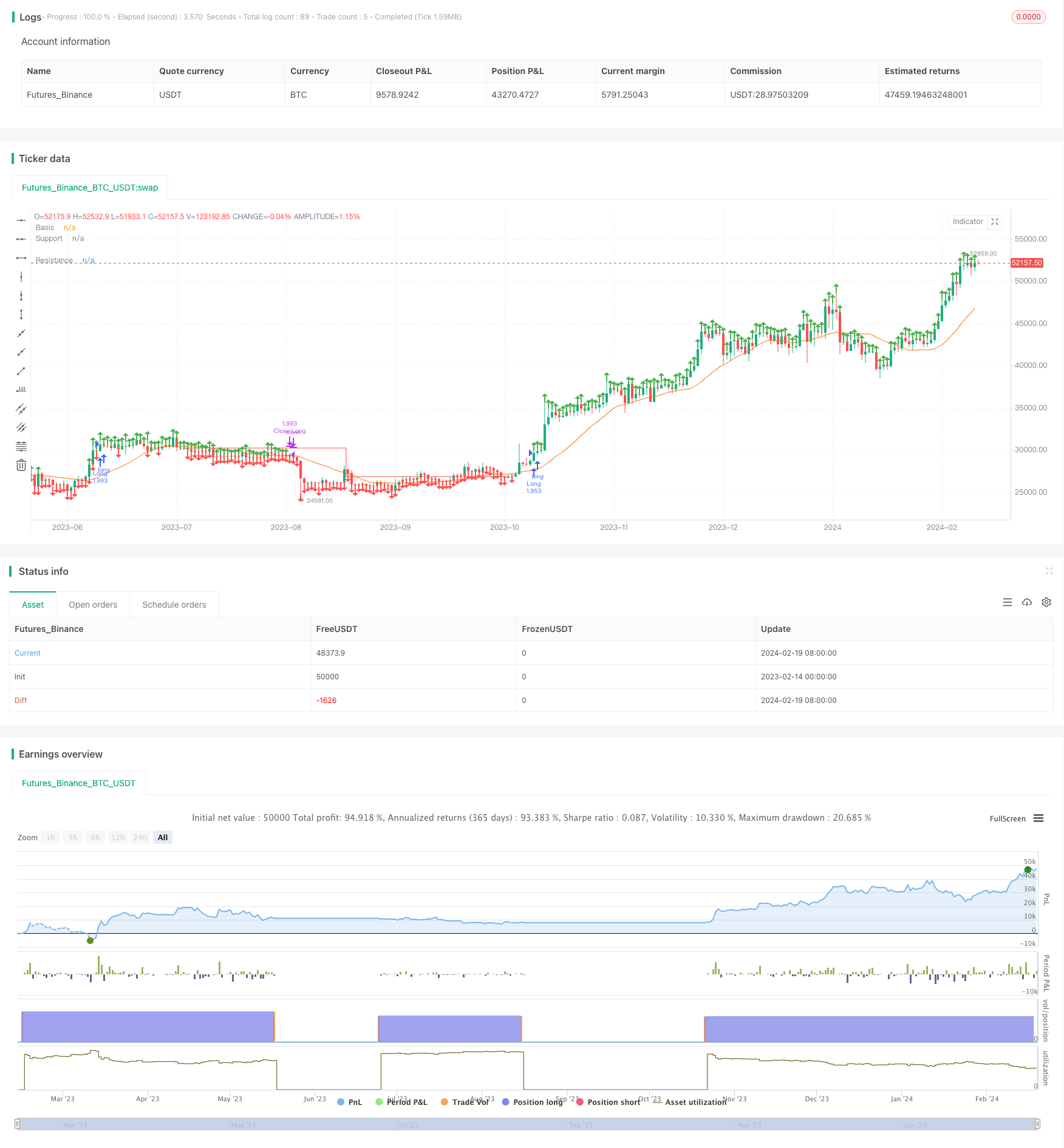পরিমাণগত অগ্রগতি আপট্রেন্ড রেফারেন্স কৌশল
লেখক:চাওঝাং, তারিখঃ ২০২৪-০২-২১ ১০ঃ৫৮ঃ০১ট্যাগঃ

সারসংক্ষেপ
এই কৌশলটি একটি দীর্ঘমেয়াদী হোল্ডিং কৌশল যা সহজ চলমান গড় রেখাগুলির সাথে প্রবণতা দিক নির্ধারণ এবং প্রতিরোধ এবং সমর্থন রেখাগুলির সাথে অগ্রগতির সংকেত গঠনের উপর ভিত্তি করে। মূল্য পিভট হাই এবং পিভট লো পয়েন্টগুলি গণনা করে, প্রতিরোধ এবং সমর্থন লাইনগুলি গ্রাফিং করে, যখন দাম প্রতিরোধের রেখাটি ভেঙে যায় এবং যখন মূল্য সমর্থন রেখাটি ভেঙে যায় তখন অবস্থানগুলি বন্ধ করে দেয়। এই কৌশলটি সুস্পষ্ট প্রবণতা সহ স্টকগুলির জন্য উপযুক্ত এবং একটি ভাল ঝুঁকি-পুরষ্কার অনুপাত পেতে পারে।
কৌশল নীতি
- প্রবণতা নির্ধারণের জন্য বেসলাইন হিসাবে 20 দিনের সহজ চলমান গড় রেখা গণনা করুন
- ব্যবহারকারীর ইনপুট পরামিতির উপর ভিত্তি করে পিভট হাই এবং পিভট লো পয়েন্ট গণনা করুন
- পিভট হাই এবং পিভট লো পয়েন্টের উপর ভিত্তি করে প্রতিরোধ এবং সমর্থন লাইনগুলি প্লট করুন
- যখন বন্ধের দাম প্রতিরোধের রেখার চেয়ে বেশি হয় তখন দীর্ঘ যান
- সমর্থন রেখা প্রতিরোধ রেখার নিচে অতিক্রম করলে অবস্থান বন্ধ করুন
এই কৌশলটি সামগ্রিক প্রবণতা দিক নির্ধারণের জন্য সহজ চলমান গড় ব্যবহার করে এবং তারপরে মূল পয়েন্টের অগ্রগতি ব্যবহার করে ট্রেডিং সংকেত তৈরি করে, যা একটি সাধারণ ব্রেকআউট কৌশল। মূল পয়েন্ট এবং প্রবণতা বিচার করে, মিথ্যা ব্রেকআউট কার্যকরভাবে ফিল্টার করা যেতে পারে।
সুবিধা বিশ্লেষণ
- কৌশলটি পর্যাপ্ত সুযোগ রয়েছে এবং উচ্চ অস্থিরতার স্টকগুলির জন্য উপযুক্ত, যা প্রবণতা ধরা সহজ করে দেয়
- লং পজিশনের জন্য ভালো ঝুঁকি নিয়ন্ত্রণ, উচ্চ ঝুঁকি-প্রতিদান অনুপাত
- ভুয়া ব্রেকআউটের ঝুঁকি এড়াতে ব্রেকআউট সংকেত ব্যবহার করুন
- কাস্টমাইজযোগ্য পরামিতি, উচ্চ অভিযোজনযোগ্যতা
ঝুঁকি বিশ্লেষণ
- প্যারামিটার অপ্টিমাইজেশান উপর নির্ভর করুন, অনুপযুক্ত প্যারামিটার মিথ্যা breakouts সম্ভাবনা বৃদ্ধি করবে
- সাইনালের বিলম্ব, কিছু সুযোগ হারাতে পারে
- অস্থির বাজারে সহজেই থামানো যায়
- সময়মতো সমর্থন রেখা সামঞ্জস্য না করলে ক্ষতি হতে পারে।
লাইভ ট্রেডিংয়ের মাধ্যমে প্যারামিটারগুলিকে অনুকূল করে এবং স্টপ লস / লাভ গ্রহণের কৌশলগুলি অন্তর্ভুক্ত করে ঝুঁকিগুলি হ্রাস করা যেতে পারে।
অপ্টিমাইজেশান নির্দেশাবলী
- চলমান গড় সময়ের পরামিতিগুলি অপ্টিমাইজ করুন
- প্রতিরোধ এবং সমর্থন লাইন পরামিতি অপ্টিমাইজ করুন
- স্টপ লস/ট্যাক প্রফিট কৌশল যোগ করুন
- অগ্রগতির নিশ্চিতকরণ ব্যবস্থা বাড়ানো
- ট্রেডিং ভলিউম এবং অন্যান্য সূচক সহ ফিল্টার সংকেত
সংক্ষিপ্তসার
সামগ্রিকভাবে, এই কৌশলটি একটি সাধারণ ব্রেকআউট কৌশল যা প্যারামিটার অপ্টিমাইজেশন এবং তরলতার উপর নির্ভর করে, ট্রেন্ড ট্রেডারদের জন্য উপযুক্ত। একটি রেফারেন্স ফ্রেমওয়ার্ক হিসাবে, এটি স্টপ লস / লাভ নিন, ঝুঁকি হ্রাস এবং স্থিতিশীলতা উন্নত করার জন্য সংকেত ফিল্টারিংয়ের মতো প্রক্রিয়া যুক্ত করে প্রকৃত প্রয়োজন অনুযায়ী প্রসারিত করা যেতে পারে।
/*backtest
start: 2023-02-14 00:00:00
end: 2024-02-20 00:00:00
period: 1d
basePeriod: 1h
exchanges: [{"eid":"Futures_Binance","currency":"BTC_USDT"}]
*/
// This source code is subject to the terms of the Mozilla Public License 2.0 at https://mozilla.org/MPL/2.0/
// © CheatCode1
//@version=5
strategy("Quantitative Trend Strategy- Uptrend long", 'Steady Uptrend Strategy', overlay=true, initial_capital = 1500, default_qty_value = 100, commission_type = strategy.commission.percent, commission_value = 0.01, default_qty_type = strategy.percent_of_equity)
length = input.int(20, minval=1)
src = input(close, title="Source")
basis = ta.sma(src, length)
offset = input.int(0, "Offset", minval = -500, maxval = 500)
plot(basis, "Basis", color=#FF6D00, offset = offset)
inp1 = input.int(46, 'LookbackLeft')
inp2 = input.int(32, 'LookbackRight')
l1 = ta.pivothigh(close, inp1, inp2)
S1 = ta.pivotlow(close, inp1, inp2)
// plot(l1, 'Pivothigh', color.red, 1)
// // plot(S1, 'Pivot Low', color.red)
l1V = ta.valuewhen(l1, close, 0)
S1V = ta.valuewhen(S1, close, 0)
Plotl1 = not na(l1) ? l1V : na
PlotS1 = not na(S1) ? S1V : na
plot(Plotl1, 'Resistance', color.green, 1, plot.style_stepline, true)
plot(PlotS1, 'Support', color.red, 1, plot.style_stepline, true)
Priceforlong = close > l1V ? true : na
Priceforshort = close < S1V ? true : na
plotshape(Priceforlong ? high : na, 'p', shape.arrowup, location.abovebar, color.green, size = size.small)
plotshape(Priceforshort ? low : na, 's', shape.arrowdown, location.belowbar, color.red, size = size.small)
vol = volume
volma = ta.sma(vol, 20)
Plotl1C = ta.valuewhen(na(Plotl1), l1V, 0)
PlotS1C = ta.valuewhen(na(PlotS1), S1V, 0)
//Strategy Execution
volc = volume > volma
Lc1 = Priceforlong
Sc1 = Priceforshort
sL = Plotl1 < PlotS1 ? close : na
sS = PlotS1 > Plotl1 ? close : na
if Lc1
strategy.entry('Long', strategy.long)
// if Sc1 and C2
// strategy.entry('Short', strategy.short)
if Priceforshort
strategy.cancel('Long')
if Priceforlong
strategy.cancel('Short')
// Stp1 = ta.crossover(k, d)
// Ltp1 = ta.crossunder(k, d)
// Ltp = d > 70 ? Ltp1 : na
// Stp = d < 30 ? Stp1 : na
if strategy.openprofit >= 0 and sL
strategy.close('Long')
if strategy.openprofit >= 0 and sS
strategy.close('Short')
takeP = input.float(2, title='Take Profit') / 100
stopL = input.float(1.75, title='Stop Loss') / 100
// // Pre Directionality
Stop_L = strategy.position_avg_price * (1 - stopL)
Stop_S = strategy.position_avg_price * (1 + stopL)
Take_S= strategy.position_avg_price * (1 - takeP)
Take_L = strategy.position_avg_price * (1 + takeP)
// sL = Plotl1 < PlotS1 ? close : na
// sS = PlotS1 < Plotl1 ? close : na
// //Post Excecution
if strategy.position_size > 0 and not (Lc1)
strategy.exit("Close Long", stop = Stop_L, limit = Take_L)
if strategy.position_size < 0 and not (Sc1)
strategy.exit("Close Short", stop = Stop_S, limit = Take_S)
- গতির সূচক সমষ্টি ট্রেডিং কৌশল
- মাল্টি ইন্ডিকেটর কোয়ান্ট ট্রেডিং কৌশল
- ট্রেডিংভিএমএ
ভেরিয়েবল মুভিং মিডিয়ার ট্রেডিং কৌশল - আরএসআই ডিভার্জেন্স কৌশল
- ডুয়াল ডোনচিয়ান চ্যানেল ব্রেকআউট কৌশল
- বোলিংজার ব্যান্ডস ব্রেকআউট ট্রেডিং কৌশল
- ইএমএ-এর অগ্রগতির ফাঁদ কৌশল
- গোল্ডেন ক্রস ডেড ক্রস ট্রেডিং কৌশল
- সুপারট্রেন্ড ভিত্তিক মাল্টিটাইমফ্রেম ট্রেন্ড ট্র্যাকিং কৌশল
- ম্যানুয়াল ক্রয় ও বিক্রয় সতর্কতা কৌশল
- পরিমাণগত ট্রেডিং প্ল্যাটফর্মের উপর ভিত্তি করে অ্যাডাপ্টিভ গ্রিড ট্রেডিং কৌশল
- ইচিমোকু ক্লাউড এবং চলমান গড়ের উপর ভিত্তি করে পরিমাণগত ট্রেডিং কৌশল
- ডাবল মুভিং এভারেজ রিভার্সাল ট্র্যাকিং কৌশল
- বোলিংজার ব্যান্ডস বিপরীতমুখী কৌশল
- ইচিমোকু কিঙ্কো হিও ক্লাউড + কিউকিউই পরিমাণগত কৌশল
- স্বর্ণের জন্য স্টপ লস সহ মোমেন্টাম ট্রেডিং কৌশল সম্পর্কে সবকিছু
- প্যারাবোলা দোলক উচ্চ এবং নিম্ন কৌশল খুঁজছেন
- বোলিংজার ব্যান্ডস ব্রেকআউট কৌশল
- ফেয়ার ভ্যালু গ্যাপ স্ট্র্যাটেজি
- ইম্পোমেন্ট ব্রেকআউট সহ অভিযোজিত চলমান গড় ক্রসওভার সিস্টেম